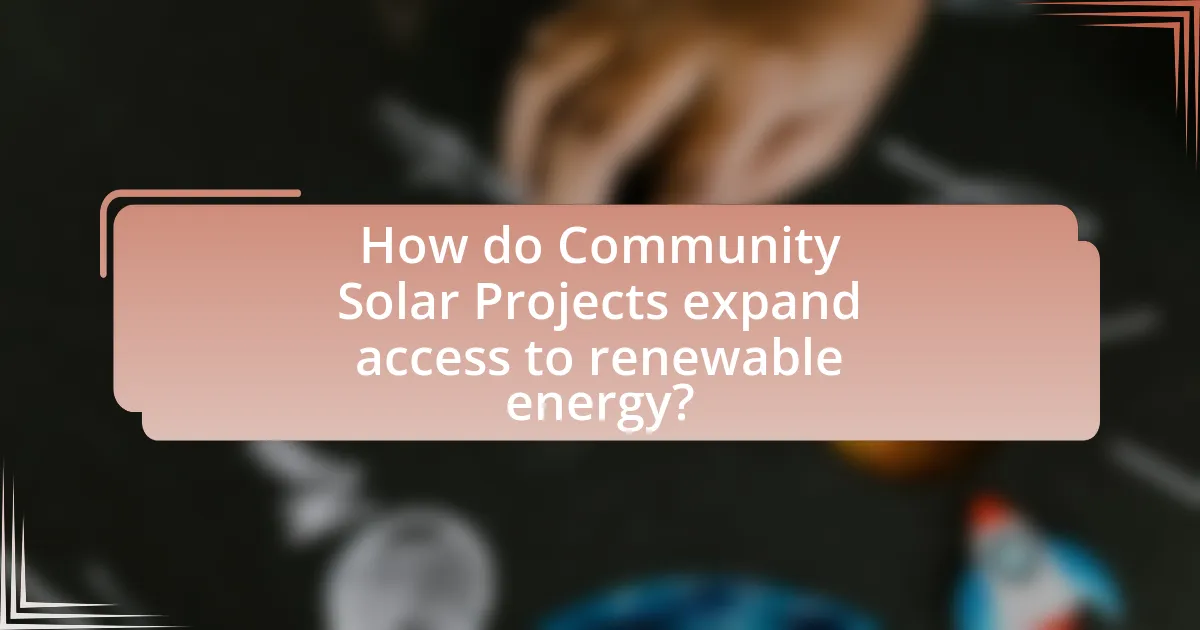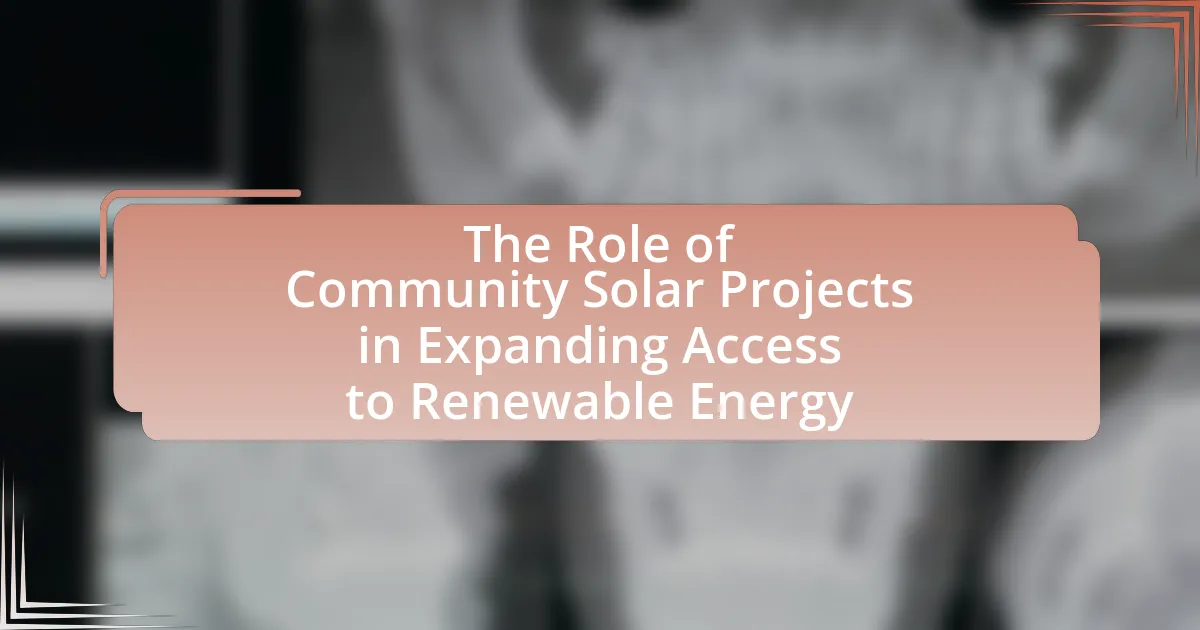Community solar projects are collaborative solar energy installations that enable multiple participants, including individuals, businesses, and organizations, to benefit from shared renewable energy resources. These projects operate by allowing participants to invest in or subscribe to a portion of a larger solar array, which generates electricity fed into the local grid, providing credits on utility bills. Key components include solar arrays, subscription agreements, and community engagement frameworks, which collectively enhance access to solar energy, particularly for those without suitable rooftops or financial means. Community solar projects play a crucial role in reducing energy costs, promoting environmental sustainability, and expanding renewable energy access, especially for low- and moderate-income households. The article will explore the operational mechanisms, benefits, challenges, and future trends of community solar projects, highlighting their significance in democratizing energy production and fostering a sustainable energy landscape.

What are Community Solar Projects?
Community solar projects are solar energy installations that allow multiple participants, often in a shared community, to benefit from the energy produced. These projects enable individuals, businesses, and organizations to invest in or subscribe to a portion of a larger solar array, typically located off-site, which generates renewable energy that is fed into the local grid. According to the National Renewable Energy Laboratory, community solar can increase access to solar energy for those who may not have suitable rooftops or the financial means to install their own systems, thereby promoting wider adoption of renewable energy sources.
How do Community Solar Projects operate?
Community solar projects operate by allowing multiple participants to invest in or subscribe to a shared solar energy system, typically located off-site. These projects generate electricity that is fed into the local grid, and participants receive credits on their utility bills based on their share of the energy produced. This model enables individuals, businesses, and organizations without suitable rooftops or financial means to access solar energy, thereby expanding renewable energy access. According to the National Renewable Energy Laboratory, community solar can increase participation in solar energy by up to 50% compared to traditional rooftop installations, demonstrating its effectiveness in broadening access to renewable resources.
What are the key components of Community Solar Projects?
The key components of Community Solar Projects include a solar array, subscription agreements, and a community engagement framework. The solar array serves as the central facility where solar energy is generated, allowing multiple participants to benefit from the energy produced. Subscription agreements outline the terms under which community members can invest in or subscribe to the solar project, often providing them with credits on their utility bills based on their share of the energy produced. A community engagement framework ensures that local stakeholders are involved in the planning and decision-making processes, fostering transparency and support for the project. These components collectively enable broader access to renewable energy, particularly for those who may not have the means to install solar panels on their own properties.
How is energy generated and distributed in these projects?
Energy in community solar projects is generated primarily through photovoltaic (PV) solar panels that convert sunlight into electricity. These projects typically involve multiple stakeholders, including local governments, non-profits, and residents, who collectively invest in and benefit from the solar installations. The generated electricity is then distributed through the local grid, allowing participants to receive credits on their utility bills based on their share of the energy produced. This model not only promotes renewable energy use but also enhances energy access for those who may not have the means to install solar panels on their own properties.
Why are Community Solar Projects important for renewable energy access?
Community solar projects are important for renewable energy access because they provide an opportunity for individuals and communities to participate in and benefit from solar energy, regardless of their property ownership or financial capacity. These projects enable shared solar installations, allowing multiple participants to invest in or subscribe to a portion of a solar array, which can lead to reduced energy costs and increased energy independence. According to the National Renewable Energy Laboratory, community solar can significantly expand access to renewable energy, particularly for low- and moderate-income households, who may lack the resources to install solar panels on their own properties. This inclusivity helps to democratize energy production and supports broader adoption of renewable energy sources.
What role do they play in reducing energy costs?
Community solar projects play a significant role in reducing energy costs by providing affordable access to renewable energy for participants. These projects allow multiple households or businesses to share the benefits of a single solar installation, which lowers individual costs compared to installing private solar systems. According to a report by the National Renewable Energy Laboratory, community solar can reduce energy bills by 10-30% for participants, making renewable energy more accessible and economically viable. This collective approach not only decreases the financial burden on individual consumers but also promotes the adoption of clean energy, contributing to overall reductions in energy costs within the community.
How do they contribute to environmental sustainability?
Community solar projects contribute to environmental sustainability by increasing the adoption of renewable energy sources, specifically solar power. These projects enable multiple participants, including those who cannot install solar panels on their properties, to access clean energy, thereby reducing reliance on fossil fuels. According to the National Renewable Energy Laboratory, community solar can lead to a significant decrease in greenhouse gas emissions, as it allows for the generation of renewable energy at a larger scale, which can displace carbon-intensive energy sources. This collective effort not only promotes energy equity but also fosters a transition towards a more sustainable energy system.

How do Community Solar Projects expand access to renewable energy?
Community solar projects expand access to renewable energy by allowing individuals and businesses to invest in and benefit from solar energy without needing to install solar panels on their own properties. These projects enable participants to purchase or lease a share of a larger solar installation, which can be located off-site, thus making solar energy accessible to those who may not have suitable rooftops or the financial means to invest in their own systems. According to the National Renewable Energy Laboratory, community solar can increase participation in renewable energy by providing options for renters, low-income households, and those in shaded areas, thereby democratizing access to clean energy sources.
Who can participate in Community Solar Projects?
Individuals, businesses, and organizations can participate in Community Solar Projects. These projects are designed to allow participants to invest in or subscribe to a portion of a larger solar energy installation, typically located off-site. This model enables those who may not have suitable rooftops for solar panels, such as renters or those with shaded properties, to access renewable energy. According to the National Renewable Energy Laboratory, community solar programs have been implemented in various states, allowing diverse participants to benefit from solar energy without the need for individual installations.
What are the eligibility criteria for participants?
The eligibility criteria for participants in community solar projects typically include being a resident or property owner within the project’s designated service area, having a utility account with the local energy provider, and meeting any specific income or credit requirements set by the project developers. These criteria ensure that participants can effectively benefit from the energy produced and contribute to the project’s sustainability. For instance, many community solar programs prioritize low-income households to enhance equitable access to renewable energy resources.
How do these projects accommodate low-income households?
Community solar projects accommodate low-income households by providing affordable access to renewable energy without the need for individual solar panel installations. These projects often include financial incentives such as reduced electricity rates or subscription models that allow low-income participants to pay only for the energy they use, making solar energy more accessible. For instance, programs like the Solar for All initiative in Washington, D.C., specifically target low-income residents, offering them the opportunity to benefit from solar energy savings while contributing to environmental sustainability.
What are the geographical considerations for Community Solar Projects?
Geographical considerations for Community Solar Projects include land availability, solar irradiance levels, proximity to existing electrical infrastructure, and local regulations. Land availability is crucial as projects require sufficient space for solar panels, typically on rooftops or open fields. Solar irradiance levels determine the potential energy output, with regions receiving higher sunlight being more favorable. Proximity to electrical infrastructure, such as substations and transmission lines, reduces costs and increases efficiency in connecting to the grid. Local regulations, including zoning laws and permitting processes, can significantly impact project feasibility and timelines. These factors collectively influence the successful implementation and operation of Community Solar Projects.
How do location and climate affect project viability?
Location and climate significantly influence project viability by determining the availability of natural resources and the feasibility of construction and operation. For instance, solar energy projects require ample sunlight; therefore, locations with high solar irradiance, such as the southwestern United States, are more viable for solar installations compared to regions with frequent cloud cover or lower sunlight exposure. Additionally, climate factors such as temperature extremes can affect the efficiency of solar panels and the durability of infrastructure. Research indicates that solar panel efficiency decreases at higher temperatures, which can impact energy output in hotter climates. Thus, understanding the specific location and climate conditions is crucial for assessing the potential success and sustainability of community solar projects.
What regions are most suitable for Community Solar Projects?
Regions most suitable for Community Solar Projects include areas with high solar irradiance, supportive regulatory frameworks, and a strong community interest in renewable energy. States like California, Arizona, and New York exemplify these characteristics, as they have abundant sunlight, established policies promoting solar energy, and active community engagement in sustainability initiatives. For instance, California leads the nation in solar capacity, with over 30,000 megawatts installed, making it a prime location for community solar development.

What challenges do Community Solar Projects face?
Community Solar Projects face several challenges, including regulatory hurdles, financing difficulties, and community engagement issues. Regulatory hurdles often arise from complex state and local policies that can vary significantly, making it difficult for projects to navigate the approval process. Financing difficulties stem from the need for substantial upfront capital, which can deter potential investors and limit project viability. Additionally, community engagement issues can occur when local residents are not adequately informed or involved in the project, leading to resistance or lack of support. These challenges can hinder the successful implementation and expansion of community solar initiatives, ultimately affecting their role in increasing access to renewable energy.
What regulatory hurdles impact Community Solar Projects?
Community Solar Projects face several regulatory hurdles, including interconnection standards, net metering policies, and state-specific legislation. Interconnection standards can vary significantly by region, leading to delays and increased costs for project developers. Net metering policies, which determine how solar energy credits are allocated, can also differ, impacting the financial viability of these projects. Additionally, some states lack comprehensive legislation supporting community solar, creating uncertainty for investors and developers. For instance, as of 2023, only 22 states and Washington D.C. have enacted laws specifically promoting community solar, limiting the potential for expansion in other areas.
How do state policies influence project development?
State policies significantly influence project development by establishing regulatory frameworks, funding opportunities, and incentives that shape the feasibility and attractiveness of projects. For instance, policies such as renewable portfolio standards (RPS) mandate a certain percentage of energy to come from renewable sources, directly encouraging the development of community solar projects. Additionally, state-level tax credits and grants can lower the financial barriers for developers, making projects more viable. Research from the National Renewable Energy Laboratory indicates that states with supportive policies see a higher rate of solar installations, demonstrating the direct correlation between policy support and project success.
What are the common legal challenges faced by these projects?
Community solar projects commonly face legal challenges such as regulatory compliance, land use disputes, and contractual issues. Regulatory compliance involves navigating complex state and federal laws that govern energy production and distribution, which can vary significantly across jurisdictions. Land use disputes often arise when projects require zoning changes or face opposition from local residents concerned about environmental impacts or property values. Contractual issues may include disputes over agreements with utility companies, investors, or participants in the solar program, which can complicate project financing and implementation. These challenges can hinder the development and operation of community solar initiatives, impacting their ability to expand access to renewable energy effectively.
What financial obstacles do Community Solar Projects encounter?
Community Solar Projects encounter several financial obstacles, primarily including high initial capital costs, difficulty in securing financing, and challenges in achieving economies of scale. High initial capital costs can deter investment, as these projects often require significant upfront funding for infrastructure and installation. Difficulty in securing financing arises from the perceived risks associated with community solar, which can lead to higher interest rates or reluctance from traditional lenders. Additionally, achieving economies of scale is challenging for smaller projects, which may not benefit from the cost reductions that larger installations can leverage, ultimately impacting their financial viability.
How do funding and investment affect project implementation?
Funding and investment significantly influence project implementation by providing the necessary financial resources to cover costs, facilitate development, and ensure operational sustainability. Adequate funding allows for the procurement of materials, hiring skilled labor, and covering regulatory compliance expenses, which are critical for the timely execution of community solar projects. For instance, a study by the National Renewable Energy Laboratory found that projects with robust financial backing are 30% more likely to meet their implementation timelines compared to those with limited funding. This correlation underscores the importance of financial support in overcoming barriers and achieving project goals effectively.
What are the risks associated with financing Community Solar Projects?
The risks associated with financing Community Solar Projects include regulatory changes, financial instability, and market demand fluctuations. Regulatory changes can impact project viability, as shifts in government policies or incentives may alter the financial landscape. Financial instability arises from the potential for cost overruns or unexpected expenses, which can jeopardize project funding and returns. Market demand fluctuations can affect the subscription rates for community solar, leading to revenue uncertainty. According to a report by the National Renewable Energy Laboratory, these risks can significantly influence the overall success and sustainability of community solar initiatives.
How can Community Solar Projects be improved?
Community solar projects can be improved by enhancing stakeholder engagement and optimizing financing models. Engaging local communities in the planning and decision-making processes fosters a sense of ownership and increases participation, which is crucial for project success. For instance, studies show that projects with strong community involvement have higher subscription rates, as seen in the Solar Gardens program in Minnesota, where community input led to tailored solutions that met local needs. Additionally, optimizing financing models, such as incorporating innovative funding mechanisms like green bonds or community investment funds, can lower barriers to entry and make projects more financially viable. Research indicates that projects utilizing diverse funding sources can achieve greater financial stability and sustainability, as demonstrated by the success of the Co-op Power initiative in Massachusetts, which combines community investment with cooperative ownership.
What best practices can enhance project success?
Effective communication among stakeholders enhances project success by ensuring that all parties are aligned on goals and expectations. Regular updates and feedback loops facilitate transparency and foster collaboration, which are critical in community solar projects. Research indicates that projects with strong stakeholder engagement are 30% more likely to meet their objectives, as highlighted in the Project Management Institute’s “Pulse of the Profession” report. Additionally, establishing clear project goals and metrics allows for measurable progress tracking, which is essential for maintaining focus and accountability throughout the project lifecycle.
How can community engagement be increased in these projects?
Community engagement in solar projects can be increased by implementing inclusive outreach strategies that actively involve local residents in the planning and decision-making processes. Research shows that projects that incorporate community feedback and address local needs tend to have higher participation rates; for instance, a study by the National Renewable Energy Laboratory found that community solar projects with strong local partnerships increased subscriber rates by up to 50%. Additionally, hosting informational workshops and utilizing social media platforms can enhance awareness and foster a sense of ownership among community members, leading to greater involvement and support for renewable energy initiatives.
What are the future trends for Community Solar Projects?
Future trends for Community Solar Projects include increased participation from low-income households, advancements in technology that enhance efficiency, and the integration of storage solutions to manage energy supply. As of 2023, community solar capacity in the U.S. has grown significantly, with over 3.5 gigawatts installed, reflecting a shift towards more inclusive energy access. Additionally, regulatory frameworks are evolving to support virtual net metering and community ownership models, which further democratize access to solar energy. These trends are driven by a growing demand for renewable energy and the need for sustainable solutions to combat climate change.
How is technology shaping the evolution of Community Solar Projects?
Technology is significantly shaping the evolution of Community Solar Projects by enhancing efficiency, reducing costs, and improving accessibility. Innovations such as advanced solar panel designs, energy storage solutions, and smart grid technology enable these projects to optimize energy production and distribution. For instance, the integration of artificial intelligence in energy management systems allows for real-time monitoring and predictive analytics, which can increase the reliability of solar energy supply. Additionally, the use of blockchain technology facilitates transparent and secure transactions among community members, making it easier for individuals to invest in and benefit from shared solar resources. According to the National Renewable Energy Laboratory, the cost of solar energy has dropped by over 80% since 2010, making community solar projects more financially viable and attractive to a broader audience.
What innovations are emerging in the community solar sector?
Innovations emerging in the community solar sector include advanced financing models, digital platforms for subscription management, and enhanced energy storage solutions. Advanced financing models, such as community solar gardens and shared solar programs, allow diverse participants to invest in solar projects, increasing accessibility. Digital platforms streamline the subscription process, enabling users to easily manage their participation and track energy production. Enhanced energy storage solutions, like lithium-ion batteries, improve the reliability and efficiency of community solar systems by storing excess energy for later use, thus maximizing the benefits for participants. These innovations collectively contribute to expanding access to renewable energy and making community solar more viable and attractive to a broader audience.
What practical steps can communities take to implement Community Solar Projects?
Communities can implement Community Solar Projects by first forming a dedicated task force to assess local energy needs and potential sites for solar installations. This task force should engage stakeholders, including local government, residents, and utility companies, to gather support and resources. Next, communities should conduct feasibility studies to evaluate the financial, technical, and environmental aspects of proposed solar projects. Securing funding through grants, partnerships, or community investments is crucial, as evidenced by the Solar Energy Industries Association, which highlights that financial backing is a key factor in project success. Finally, communities must navigate regulatory requirements and obtain necessary permits, ensuring compliance with local, state, and federal laws to facilitate the installation and operation of solar facilities.


